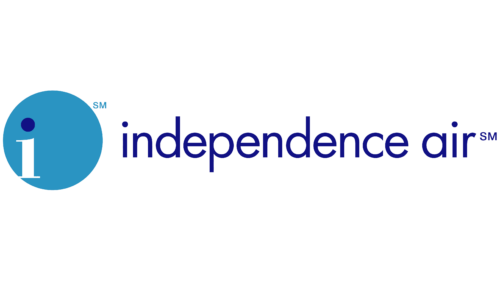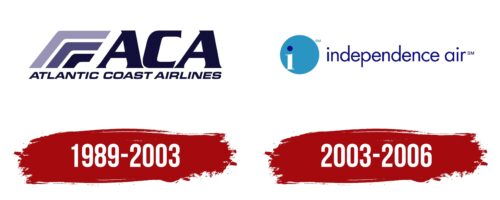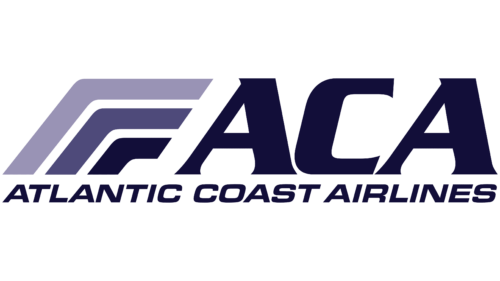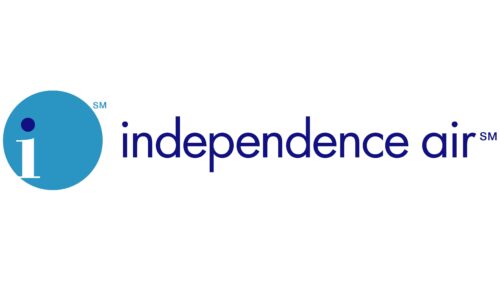The Independence Air logo symbolized a spirit of freedom and self-determination central to the airline’s identity. It reflected the company’s ethos of offering an independent choice in an industry often dominated by large carriers, providing passengers with an alternative for a more personalized flying experience. This design highlighted the airline’s commitment to service and value, aiming to expand travelers’ options by offering flexible and affordable travel solutions.
Independence Air: Brand overview
In 1989, Independence Air was founded as Atlantic Coast Airlines, a regional airline that operated turboprop flights in cooperation with major airlines. In the 1990s, it evolved into one of the most prominent regional airlines in the United States, known for its extensive feeder routes.
In 2003, the airline’s management undertook a change: Atlantic Coast became a budget airline, marking its transformation into Independence Air. By June 2004, the transformation was complete, and the airline began operating point-to-point flights primarily out of Washington, D.C., using a fleet of Boeing 737 jets.
However, the airline struggled to compete with well-established low-cost carriers offering similar routes at even lower prices. Financial pressures mounted, and eventually, Independence Air was forced to declare bankruptcy, leading to a shutdown in January 2006.
At its peak, Independence Air had a fleet of more than 50 airplanes and a workforce of about 4,000 employees. In the 19 months, the airline served 56 destinations in the United States, the Caribbean, and Canada.
Despite its short existence, Independence Air remains a daring attempt to enter the low-cost airline market. The airline’s failure is a stark reminder of the industry’s stiff competitive and economic hurdles.
Meaning and History
What is Independence Air?
It is a budget airline based in the United States, headquartered at Washington Dulles International Airport. It operated primarily on the East Coast, offering a network of domestic flights to provide affordable air transportation. Known for its branding and increased focus on customer service, it utilized a fleet of small regional jets and Airbus A320 aircraft. Despite its popularity and efforts to attract customers, the airline faced financial difficulties and ceased operations less than three years after launch.
1989 – 2003
Independence Air, operated from 1989 to 2003, developed a unique logo that subtly reflected the company’s ideology and direction. The logo was carefully crafted to symbolize the brand’s core values: innovation, reliability, and a commitment to excellence.
The design featured curved lines on the left, forming an airplane’s keel image. These lines visually emphasized dynamism and forward direction and symbolically suggested the flight trajectory, implying the airline’s smooth and rapid advancement.
The logo’s color gradient transitioned from transparent to deep purple, creating an impression of an airplane gradually ascending from the ground to the sky. This transition of colors represented a metaphor for the company’s growth and development, starting from its foundation and swiftly moving toward success in the aviation industry.
The logo’s shades of purple and lilac were chosen for their symbolic meaning. Traditionally associated with reliability and technical excellence, these colors highlighted Independence Air’s high standards and quality of service. Purple is linked with luxury, prestige, and innovation, which allows the company to emphasize its market status and ambitions.
The blue color scheme in the logo was selected to highlight the company’s geographical location near the ocean on the U.S. coast. Blue, symbolizing the sea and sky, was ideally suited for an airline operating flights over water.
The three letters of the abbreviation and three lines in the logo harmoniously combine, creating a sense of balance and completion in the composition. Below the logo, the full original name of the airline—Atlantic Coast Airlines—follows, serving as a reminder of the company’s roots and history, an important aspect for strengthening customer trust and loyalty.
2003 – 2006
Independence Air was known for its iconic logo, which featured a large light blue circle with a white “i” inside. The dot above the “i” was dark blue, matching the adjacent text. The circle symbolizes airspace, conveying a sense of safety and security. The brand name used simple lowercase sans-serif glyphs.
The light blue circle represents the sky and flight, giving a serene and calm feeling. The dark blue dot and text add depth and contrast, enhancing the logo’s visual appeal. The simple sans-serif font reflects the airline’s straightforward approach, emphasizing simplicity and safety. This design aims to evoke trust and reliability in potential customers.
The large light blue circle anchors the design, representing the vast sky and creating a calming effect. The white “i” within the circle stands out, symbolizing clarity and approachability, aligning with the airline’s commitment to customer service. The dark blue dot adds a touch of elegance and professionalism, complementing the adjacent text.
The color palette of light blue and dark blue reinforces trust and reliability, which are essential for any airline. The lowercase sans-serif glyphs contribute to a modern and clean look, reflecting the airline’s focus on a seamless and uncomplicated travel experience.






